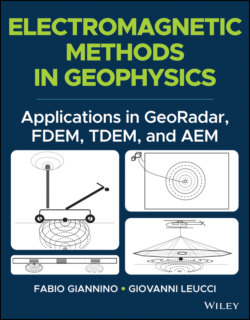Читать книгу Electromagnetic Methods in Geophysics - Fabio Giannino - Страница 20
2.2.2. The Relation Between the Primary and Secondary EM Field
ОглавлениеAs mentioned above, when an alternating current of frequency f and intensity Ip flows within a transmitting coil, it generates a magnetic field that is called primary magnetic field. This magnetic field, spreads in all the directions, including the subsoil. Also, if a receiving coil is located at a distance s from the transmitter, part of the magnetic field directly arriving at the receiver from the transmitter coil, holds the same phase and amplitude of the EM signal spread out form the transmitter (Figure 2.2.3).
At the same time, the portion of magnetic field (primary) reaching the subsoil, will induce the subsoil itself (according to the Faraday’s law) to generate an electric current (eddy current) having the same frequency of the primary field, but with a 90° (π/2) phase difference.
These electric currents (the eddy currents, the so‐called secondary), in turn, will flow into the subsoil according to the Ohm’s law (I = ∆V/R, where ΔV is the voltage and R is the electric resistance of the medium), and shows, according to the Ampere’s law, a magnetic field associated (secondary) that, once detected by the receiver coil, shall have a phase difference with respect to the primary, equals to φ.
The phase difference φ depends upon the conductors (medium) physical properties, and it is represented by the following mathematical equation:
(2.2.10)
In 2.2.10, L represents the inductance (being this the property of an electric conductor or circuit that causes an electromotive force to be generated by a change in the current flowing) and R the electrical resistance.
Thus, the total phase difference between the primary and the secondary magnetic field, shall be:
(2.2.11)
Figure 2.2.3 Sketch of the propagation of an EM filed generated by a transmitter. Ip is the electric current generated at the transmitter (primary, dashed line), Is is the induced electric current (secondary, dashed‐point line). Dashed‐point lines indicates the secondary magnetic field, whereas dashed lines indicate the primary magnetic field. S is the coils spacing
(modified from F. Giannino, 2014).
A sketch of the phase relation between the primary and the secondary, is illustrated in Figure 2.2.4.
It can be observed that, when EM measurements are carried out at high‐conductive areas, R tends to 0 and φ tend to π/2 (90°), and the phase of S is about ‐180° with respect to R.
On the other hand, when high‐resistive targets are present in the subsoil, R tends to ∞ and φ tends to 0, with the phase of S at ‐90° with respect to R (D.S. Parasnis, 1979).
Furthermore, it should be noticed that S may be factorized into its components S sin φ and S cos φ: S sin φ is the so‐called Real component (Re, in phase) and S cos φ is the imaginary component (Im, quadrature). As the ratio between the in phase (real) and quadrature (imaginary) component, depends upon φ, this is also a measure of the electrical conductivity of the medium where the EM primary field propagates: the higher the ratio Re/Im the higher the electrical conductivity (P.V. Sharma, 1997).
It can be said that the in phase component is more sensitive to conductive material, whereas the quadrature component is more sensitive to the resistive materials.
Figure (2.2.5), illustrates the response of the Real and Imaginary component of a secondary magnetic field, due to a homogeneous EM field, and in relation to the ratio R/ω.
From Figure 2.2.5 it can be observed that a good conductor produces a strong Real component but a rather poor Imaginary component response (at high frequency), whereas an high‐resistive material (poor conductor), it produces a wide imaginary component, but a poor real component (low electrical conductivity and low frequency).
